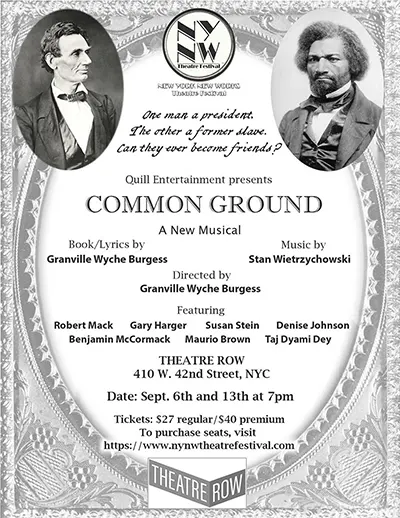Common Ground
 Book & Lyrics – Granville Wyche Burgess
Book & Lyrics – Granville Wyche Burgess
Music – Stan Wietrzychowski
Escaping from slavery in 1836, eighteen-year-old Frederick Douglass vows to his wife-to-be, Anna, that he will be a “Moses” to his people. He gets his chance when Lincoln issues the Emancipation Proclamation on January 1, 1863. Lincoln struggles to answer “What Do We Do With The Negro?” and decides that separating the two races through colonization is the only answer: as he emphasizes “I have never met a black man who is equal to a white.”
Despite Lincoln’s decision not to pay them equally, Douglass persuades outraged blacks that “This Is Our Moment”: we must join the Union army and fight for our freedom. He goes to the White House to demand equal pay for Negro soldiers and he and Lincoln argue in “Let’s Agree To Disagree.” Lincoln, impressed, wonders if he can ever get passed his prejudices to see with “Desdemona Eyes.” At the battle of Fort Pillow, Nathan Bedford Forrest slaughters captured Negro soldiers. Douglass demands that Lincoln retaliate, but Lincoln decides to do nothing. Fed up, Douglass vows that he will no longer “Wait! Wait! Wait!”
Act II: Douglass fights against Lincoln’s re-election in 1864. Fearful of losing and bone-weary from war, Lincoln despairs: “What If?” he can’t succeed and all his dreams for his country are shattered? Douglass visits the White House again and confronts Lincoln, demanding “When do we get our justice?!” Thrusting a sharp letter opener into his hands, Lincoln dares Douglass to retaliate then and there: “Payback for all your blood drawn with the lash!” When Douglass cannot, Lincoln says simply that “Vengeance is not so easy as you thought, is it?” Douglass replies: “No, and neither is forgiveness.” Lincoln pleads with Douglass to find the common ground of friendship and go forward together. Alone, Douglass agonizes over Lincoln’s offer and finally decides “Let Me Begin.”
At the inaugural ball, Douglass dramatically demands entrance but soldiers forbid him: “No Negroes allowed!” Lincoln appears and personally brings Douglass into the ballroom, where he shocks the high society crowd by introducing him as “my friend Douglass.” He has at last met a black man he knows is more than equal to a white. Lincoln and Mary waltz, the stage is filled with dance, and the air is filled with hope.
John Wilkes Booth appears in a spotlight, points a gun at the audience—at our future—and fires. “My God they’ve shot the President” Mary screams, and we dissolve to 1876 and the dedication of the Emancipation Monument, where Douglass eloquently urges everyone not to let the legacy of his friendship with Lincoln remain incomplete and the company sings of the promise of one day finding “Common Ground.”
Subplots involve:
- the relationships between the married couples, complicated by Mary’s insane jealousy and Douglass’ white mistress, as they all struggle over “Where Are The Dreams We Dreamed?
- Lincoln’s cabinet debating with him and amongst themselves, then following Lincoln’s instructions in the “Political Sidestep Strut.”
- Booth’s crazed fantasy of “Playing Brutus to His Caesar.”
